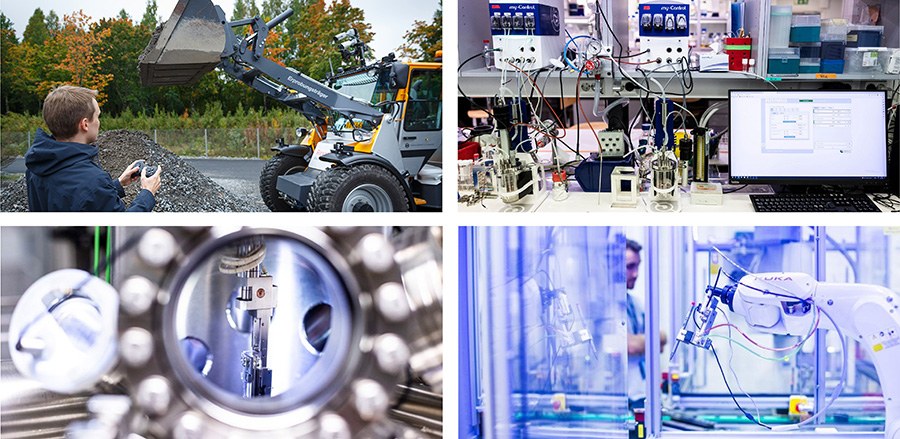World-class research cannot be conducted without research infrastructures

Research infrastructures include laboratories, equipment, devices, data networks, databases, materials, software, or related services. They can be centralised, decentralised or virtual entities or combinations of these. Without them, it is not possible to conduct research.
Research infrastructures facilitate research collaboration, researchers’ training and expertise, and research and innovation capacity. Together, they form innovative and inspiring research environments. In addition to a research infrastructure, a research environment comprises operating and cooperation models, as well as staff, its competence and research funding.
Read more about the research infrastructures at Tampere University
Investment programme provides opportunities to boost development work
More than half of Tampere University’s €380 million annual budget is used for research activities. The foundation-based Tampere University has had an investment programme since the beginning of its operations in 2019. Previously, the investment programme was implemented by Tampere University of Technology. Of the €8.5 million earmarked for the programme last year, approximately six million was allocated to the development and maintenance of various equipment, databases, and other research tools.
Vice President for Research Tapio Visakorpi sees the investment programme as an undisputed strength of the University. He says that the programme has been admired at other Finnish universities too, because not all of them have a similar one yet. However, according to Visakorpi, Tampere has only recently begun to seriously invest in research infrastructures.
“Partly thanks to the programme, we have good research infrastructures, but they need to be developed and managed in a more systematic way. They are important because they directly affect the University’s attractiveness as an employer,” Visakorpi notes.
Permanent funding lays the foundation for high-impact research
Research infrastructures broadly support high-impact top research, which makes their life cycle long. Establishing, developing, operating, maintaining, and dismantling of research infrastructures is expensive and requires sufficient and permanent resources throughout their life cycle. Money is needed from several sources for years and even decades.
The Finnish Research Infrastructure Committee of the Research Council of Finland is responsible for the strategic development of the research infrastructures, managing the FIRI funding, and monitoring national and international memberships, as well as funded projects.
Merja Särkioja, Senior Science Adviser at the Research Council of Finland says that in the future research infrastructures will also play an increasingly important role in the research data management. The role of impact is also growing. The impact of research goes hand in hand with the permanence of funding: each defines the other.
“Researchers must show they can handle the data. As a funder, we seek large entities, broad impact in society. Our goals are largely the same as those of top research,” Särkioja emphasises.

Research infrastructures on the roadmap will need funding totalling an estimated €2.7 billion by 2030.
Tampere University participates in ten research infrastructures selected for the Research Council of Finland’s FIRI 2021–2024 roadmap. In addition, the University is involved in several international infrastructure networks.
Extensive utilisation increases the impact of research infrastructures
The research infrastructures on three campuses and seven faculties at Tampere University are primarily intended for research activities. Not only researchers and students, but also partners, e.g., companies, can use or rent them.
Visakorpi emphasises, that the research infrastructures are based on openness and all those who need them have access to them. There are differences in pricing between faculties. Unlike others, the Faculty of Medicine and Health Technology is used to putting a price tag on the use of the infrastructures.
In addition to researchers within the University, there are users for all research infrastructures from other academic communities and companies.
“Since expensive research infrastructures have been built, it is important that they are also used,” Visakorpi notes.

The University’s development of research infrastructures supports faculties
According to Minnamari Vippola, Vice Dean for Research at the Faculty of Engineering and Natural Sciences, the University’s research infrastructure activities in recent years have provided large support for facilities in their own development work. The first condition for more extensive use of research infrastructures is to improve their visibility. Vippola participates actively in the development of research infrastructures at the university.
“All research infrastructures at Tampere University, and the opportunities they offer, have already well become more visible to the wider audience on the website and via the TUNICRIS research portal,” Vippola mentions.
The investment programme, which has been in operation for years, provides a solid funding base for the development of the faculties' research infrastructures. It is complemented by funding instruments at the national level, most importantly the Research Council of Finland’s FIRI funding, about which Särkioja was talking at the Science Day.
In Vippola’s view, the visibility and long-term development of research infrastructures bring key competitiveness to the faculty’s research. High-impact and accessible infrastructures attract top scientists to work as employees and better involve significant companies and other partners in the cooperation. The research infrastructures are thus an essential part of the University’s societal impact.
See all the research infrastructures at Tampere University.
Further information
Tapio Visakorpi
+358 50 318 5829
tapio.visakorpi [at] tuni.fi
Minnamari Vippola
+358 40 849 0148
minnamari.vippola [at] tuni.fi
Merja Särkioja
+358 295 335 111
merja.sarkioja [at] aka.fi
Author: Anna Aatinen







